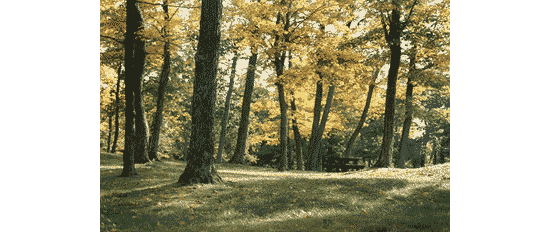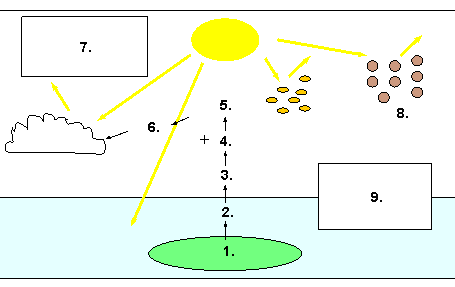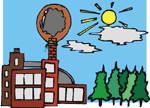|
|
 |
|
1. The absorption of CO2
Nearly all plants on Earth have to take up carbon dioxide in order to grow, because this gas provides the carbon atoms for the organic compounds in the cells of the plants.
When the formation of biomass is made possible by the energy of the sun and carried out by the chlorophyll in plant cells, we call the process photosynthesis.
Chlorophyll gives the green colour to many plants. Due to photosynthesis many plants are a sink for the greenhouse gas CO2. We know that trees take up a lot of CO2, but also the tiny phytoplankton in the oceans is a very important sink, because there is so much of it in the oceans.
However, phytoplankton does not only play a role as sink for carbon dioxide but releases other gases to the atmosphere itself. Such gases are relevant for the climate system as well.
|
 |
 |
|
Parks function as oxygen producers (source: Hemera, Big Box of Art)
|
|
Exercise 1:
Try to assume the correct words to the numbers (download the worksheet).
|
 |
 |
|
The absorbtion of CO2, author: Lucinda Spokes, Norwich, modified by Julia Heres
|
|
1. ________________________
2. ________________________
3. ________________________
....
9. ________________________ |
 |
Missing words:
- Dust particles
- sulphate aerosols
- DMS
- phytoplankton
- CCN
- cooling-indirect light scattering by clouds
- cooling-direct light scattering by aerosols
- DMS
- iron
|
|
In the text we learned, that phytoplankton does not only need sunlight and carbon dioxide in order to grow, but also some nutrients. In most cases the ions of nitrogen and phosphor are the limiting factors, but in some cases enough of them is available and phytoplankton growth is prevented nevertheless.
The scientist John Martin once said that he could make the next ice age
appear, if he was given a tanker, filled with iron.
Exercise 2:
What did he mean by that? |
|
Exercise 3:
Fill the gaps with the right words.
In some regions of the oceans ________________________________ are available in sufficient amounts for the growth of phytoplankton.
But the __________________ of iron can be a limiting factor.
The growth of the tiny ________________________ in the oceans is of some importance for the climate system. There are big amounts of it in the water and it is a sink for ______________ (carbon dioxide).
Like many other plants also phytoplankton takes up CO2 during ________________________, when enough sunlight is available. During this process ___________________ is built up and oxygen released.
Some phytoplankton species produce the _____________________ containing gas dimethyl sulphide. In the atmosphere this dimethyl sulphide may react for example with iron to form sulphate aerosols.
The ___________________________ reflects on the one hand sunlight back to the space and causes in this way a cooling of the Earth. On the other hand it acts as condensation nuclei for _________________________. Also clouds reflect sunlight back to the space, but depending on the cloud type the cooling effect may be cancelled out by the ___________________________ of clouds absorbing heat radiation from the Earth.
We see, that iron in the air and in the sea can be an important factor in our climate system. The main impact however does not come from the reflection of the sunlight, but from the __________________________. When much more phytoplankton grows in the ocean and much more dying phytoplankton sinks to the deep sea, much more CO2 is removed from the atmosphere and stored in the deep ocean.
Some scientists suggest that this could be a way to remove a _________________________________ which is released by humans as exhaust gas from fossil fuel burning.
|
 |
 |
|
Clipart 2, Hemera, Big box of art
|
|
 |
|
Missing words:
nitrate and phosphate, uptake of CO2, phytoplankton, sulphate aerosol, sulphur, cloud formation, fraction of carbon dioxide, biomass, greenhouse effect, photosynthesis, sulphate aerosol, lack
|
|
Exercise 4
Let´s test, if you got the message from the text:
Click the GREEN button, if you think that the answer is correct and the RED button, if you think that the statement is wrong.
|
a) The rising concentration of greenhouse gases in the atmosphere causes global warming.
|
 |
|
b) Rising emissions can reduce the amount of greenhouse gases.
|
 |
|
c) Forests are huge storages of coal, which can reduce the amount of CO2 in the air.
|
 |
|
d) The iron in the sea prevents phytoplankton from growing.
|
 |
|
e) A fraction of the phytoplankton, which died, sinks to the ground and makes CO2 storage in the deep sea possible.
|
 |
|
f) The biological balance of the sea is not influenced by the addition of iron.
|
 |
|
g) The fertilization with iron may cause microbiological processes, which produce stronger greenhouse gases, such as methane.
|
 |
|
About this page:
- Author: - Bernd Wohlhöfer - University of Nürnberg - Germany
- scientific reviewing:
- educational reviewing: Prof. Dr. Schrettenbrunner / Dr. Schleicher / J. Heres
- last update: 08/02/04
|
|
 |
|









